
When it comes to productivity and focus, I have a secret weapon — a book that I never see anyone talking about.
Now, I know not everyone is a nerd about planning, scheduling, and setting goals, but there is a book by J.D. Meier that’s just fantastic.
It’s called Getting Results the Agile Way. (It’s free on KindleUnlimited, but since it’s more of a workbook I recommend getting the paperback.)
This book is jam-packed with ideas and practical systems for helping you manage your time and priorities. I first went through this book nearly five years ago, and it had a significant impact on the time management system I use today and on which I based The Focus Course.
I say Meier’s book is a secret because I’ve never heard anyone talk about the book anywhere. (Perhaps it’s the fault of the cover design, which, honestly, isn’t great.)
In his book, Meier identifies 30 pitfalls to productivity. These are common pitfalls that limit your results and cause immense friction and roadblocks to your workflows and systems.
Moreover, these pitfalls can be found in your own individual productivity systems as well as within your teams and even within your whole company.
Of the 30 pitfalls that Meier lists, the five most common are:
Analysis Paralysis: You are constantly waiting to take action until you have more information, call more meetings, get more opinions, etc.
Doing It When You Feel Like It: You wait for motivation and inspiration before you get started, and you lack a routine of doing your most important work on a regular basis.
Not Knowing the Work to Be Done: You lack clarity about things as granular as the next step or as macro as the whole big picture, thus you can’t plan accordingly.
Lack of Boundaries: You allow work to spill over into other areas of your life (weekends / evenings); you push yourself past your limits; you allow urgency to become the dominant factor surrounding your work.
Perfectionism: This bites you before, during, and after a project. Perhaps you don’t even begin because you know you won’t be able to do it just right. Or you never finish because you’re incessantly fiddling and trying to get things just right. Or, once you’ve shipped, you’re beating yourself up over how things could have been better.
Do any of these pitfalls sound familiar to you?
Perhaps you see them at work within your office culture or within your own life. Or both!
For me, numbers 1 and 5 are what I’ve most had to learn to overcome. I also use to suffer from a terrible case of #3, but that has changed completely for me over the years — a story for another time, perhaps.
Here are some related links where we’ve discussed other pitfalls and ways to bolster your productivity:
FYI: I put together all my book notes from Cal Newport’s book, Deep Work and combined those notes with all the key takeaways and highlights from my interview with Cal. If you haven’t already, you can download the in-depth notes here.
Here are the things we published this week and last. You can also stay up-to-date by following us on Twitter and RSS.
Also, we have a weekly email newsletter that sums up all the new and cool things published to the site. If you like to stay up-to-date via email, then you should sign up here.
What’s so great about relational databases?
We have been big fans of Notion for a while now, and relational databases are what makes Notion, well Notion. If you had a lot of organized spreadsheets next to each other that would be great, but in Notion your organized spreadsheets talk to each other. Relational databases connect everything together.
You can see which projects are connected to which clients and what contractors you hired for that project, or how much you need to bill a client for that project, and more — all in one place. It’s pretty great.
Years ago, Shawn embarked on his journey to go “paperless” in his personal and work life. Inspired by David Sparks’ Paperless Field Guide, he incorporated three important components:
In this Quick Tip, we are mostly going to focus on Hazel, but the scanners are worth a brief mention. Office scanners are great if you have a decent amount of stuff to scan and you want good-quality scans. iPhone scanning apps are ideal for scanning things quickly on the go. As digital as the world has become, we still have to scan stuff (receipts, medical bills, important documents — no matter how many times you “opt-in for paperless post”).
Way, way back when, Shawn showed off one of his cool tricks for spurring the creative juices each morning. Rather than sitting down cold turkey at the computer to begin work for the day, Shawn would leave a note right in front of his keyboard the prior evening outlining the next step, the next idea, or the next topic to write. Rather than sitting down to chaos, the note provided a clear path forward for Shawn.
This was my first introduction to a “startup” routine.
Honestly, the introduction didn’t root — I only developed a startup routine about five or six months ago.
I had no idea what I was missing. Since adopting my own startup routine, I’ve never felt so in control. I wake up in the morning with a new shot of confidence and a spurt of energy because I know what’s coming. I know what I’m in for. Less reaction. More action.
I can point the rooting of this startup routine to the discovery of Sunsama. Sunsama has done a number of things for my life in recent months. The app has rooted this startup routine and is developing a shutdown routine. The app helps me come to grips with an immense workload and an acceptance of my limits each day. The app helps track my time, carve out moments of personal time, and ensure my actions are aligned with my objectives each week. Sunsama has quickly become one of the most fundamental apps in my workflow.
This startup routine, though? It’s this startup routine in Sunsama which has altered how I work.
You need input, advice, and inspiration in order to make decisions, come up with new ideas, or take action on something.
But with too many inputs (especially too many non-essential inputs), your ability to think clearly and make decisions is hindered. It leads to less progress, dual focus, and, ultimately, very little traction.
How would you describe your average day?
Here are some common answers I see to this question. People often describe their day as being:
In contrast, how would you describe your ideal day? How do you WISH your average day was?
For me, my average day is generally fulfilling, fun, and productive.
As much as I love a good vacation in the Colorado mountains, I would get a bit stir crazy if I didn’t ever have something to put my hand to. And, of course, if all I ever did was work, I’d burn myself out — which is what I used to do.
I used to work 70 hours a week. In 2015 I only took about 10 days off the whole year. I even worked over my Christmas vacation! Yikes.
It took me years to become comfortable with taking time off. Evenings, weekends, long lunches, even vacations… I would feel guilty if I wasn’t cramming every minute of my day with something productive and important.
Dr. Richard Swenson writes, in his book on Margin, that we must “develop the necessary underpinnings for margin that will allow us to accept its importance without guilt. For just as we need to eat and sleep, so we also need to breathe.”
When you’re at capacity, there is no room for anything else. But when there is space left over — when there is margin — that space enables you to breath.
Introducing the new Focus Boosters.
Inside our popular community membership, join us for a the Habit Building challenge (a.k.a. “Booster”). You’ll find out how to make simple changes that will make your daily life better, remove distractions, and create a new simple habit.
Membership Includes: Simple Habits Course, Habit Tracking Templates, Digital Planner, Private Community Slack, 2x Monthly Coaching Calls, and much, much more…
We spend an inordinate amount of time sorting through hundreds of apps to find the very best. We put together a short list of our must-have, most-used apps for increasing productivity.

We have been big fans of Notion for a while now, and relational databases are what makes Notion, well Notion. If you had a lot of organized spreadsheets next to each other that would be great, but in Notion your organized spreadsheets talk to each other. Relational databases connect everything together.
You can see which projects are connected to which clients and what contractors you hired for that project, or how much you need to bill a client for that project, and more — all in one place. It’s pretty great.
You create a relational database by simply connecting two databases together using a property called relation. This tells one database to pull in information from another database.
Let’s look at an example.
Say that you have a database called Exercise Log. If you want to know what meal you ate after a particular workout, you would connect your Food Log to your Exercise Log using a relation.
To create a relation between two databases, click + Add a property, then scroll through the property options until you find Relation. You can do this from the main database view or inside of a specific card.
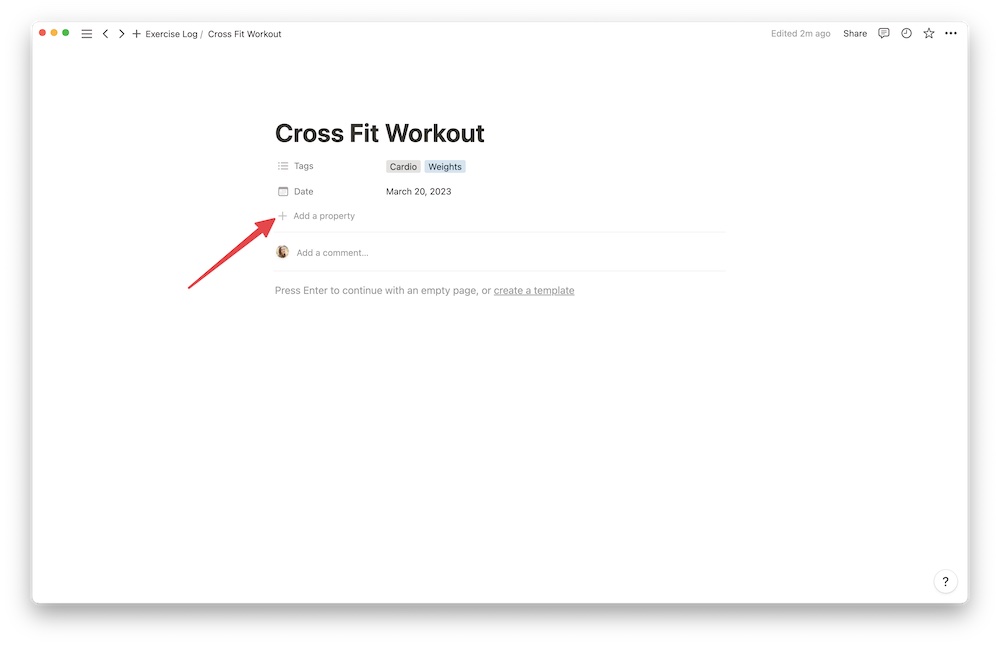
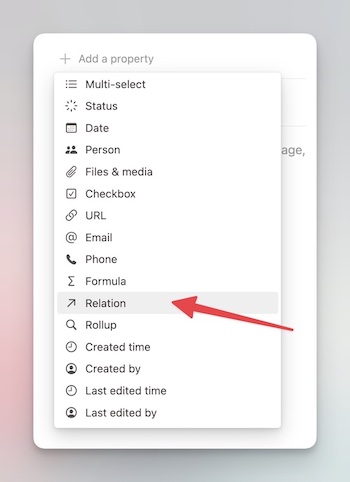
Then, you will see all the different databases you can connect to. We are going to choose Food Log for this example.
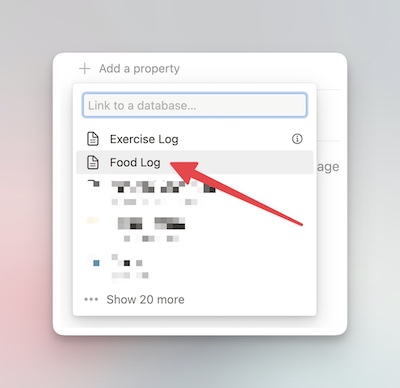
Then, you adjust the settings for the relation. We want this relation to show up on both databases, so click Show on Food Log.
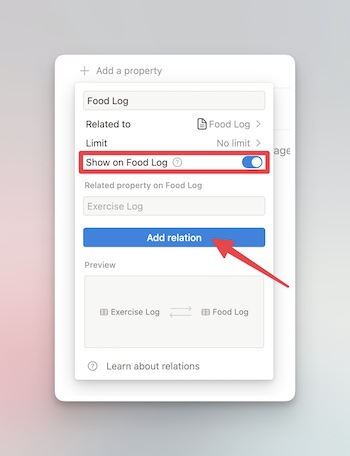
Once the database is all set up, you choose the entry from the other database that you want to connect, and voila, it’s connected!
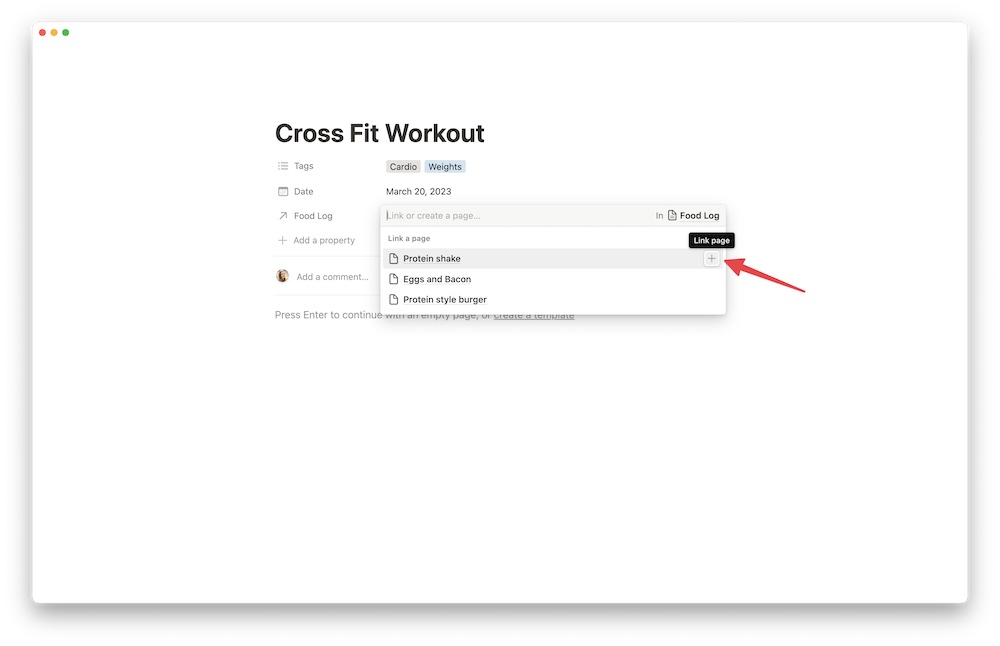
And now when you head over to Food Log, you will notice that Cross Fit Workout appears in the entry for Protein Shake.
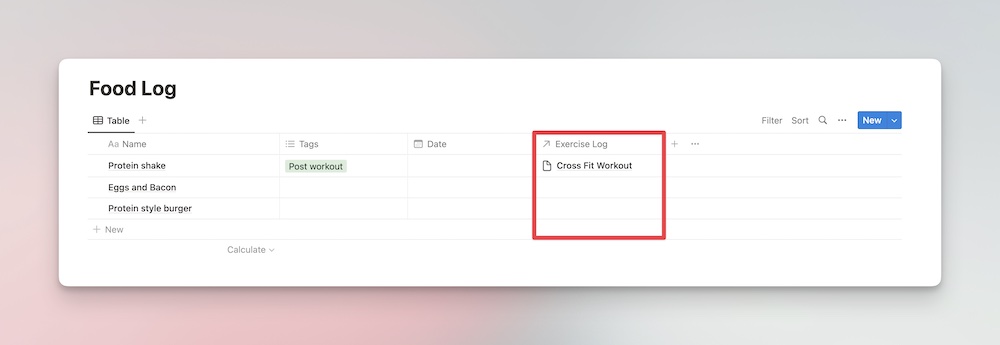
This is a pretty simple example, but it should give you a good idea of how they work. Now let’s look at some more complex use cases of Relational Databases.
Here at Blanc Media, we have a lot of important databases that we want to relate to each other. At any given moment, we are working on between 5-10 projects, in addition to our normal day-to-day stuff (like our newsletters, blog posts, etc.). So we want to make sure everything is organized and easily accessible.
From our project database, we can easily see all the emails associated with the project, all the tasks, files, messages (that’s what we call our notes), product information, and loads of other relevant information. Oh, and did we mention this all happens automatically because we set up a brilliant project template?
One of our largest projects, Accelerator, has a ton of important information that we want to keep track of. We’ve gotten pretty good at making sure we “file” everything in the right place when we add/create it in Notion so that when we use relational databases, they are actually useful.
As you can see in the red boxes, we have several connected databases.
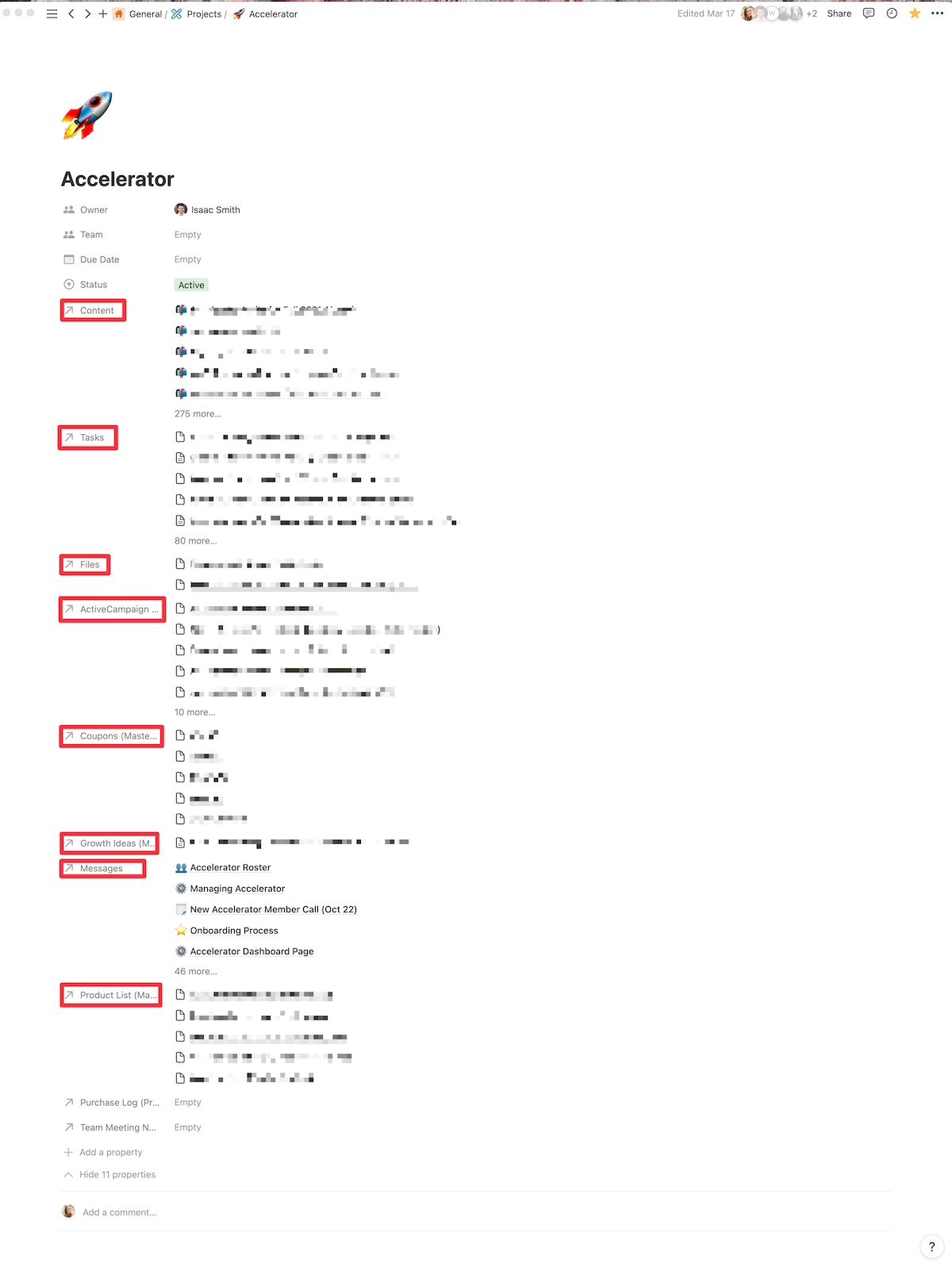
We want our main databases talking to each other. We want the task database talking to the project database so that when a task gets assigned to a specific person they know what it’s for. We want our Files database connected to our projects database; otherwise, it would be the equivalent of having a bunch of loose papers all over your floor, and you’d have no idea what anything was for.
Another crucial connection we’ve made using relational databases is for our editorial calendar. Our editorial calendar is not for the faint of heart. We create a lot of content for a lot of different channels, and we need to know what each piece is for at a glance. Relational databases help keep things organized and talking to each other.
As a writer who is in our editorial calendar a lot, context is everything. We can jump into this email that Isaac wrote and quickly see that it is for the Accelerator project. And remember the Content relation from the Accelerator project? This email will show up there too.
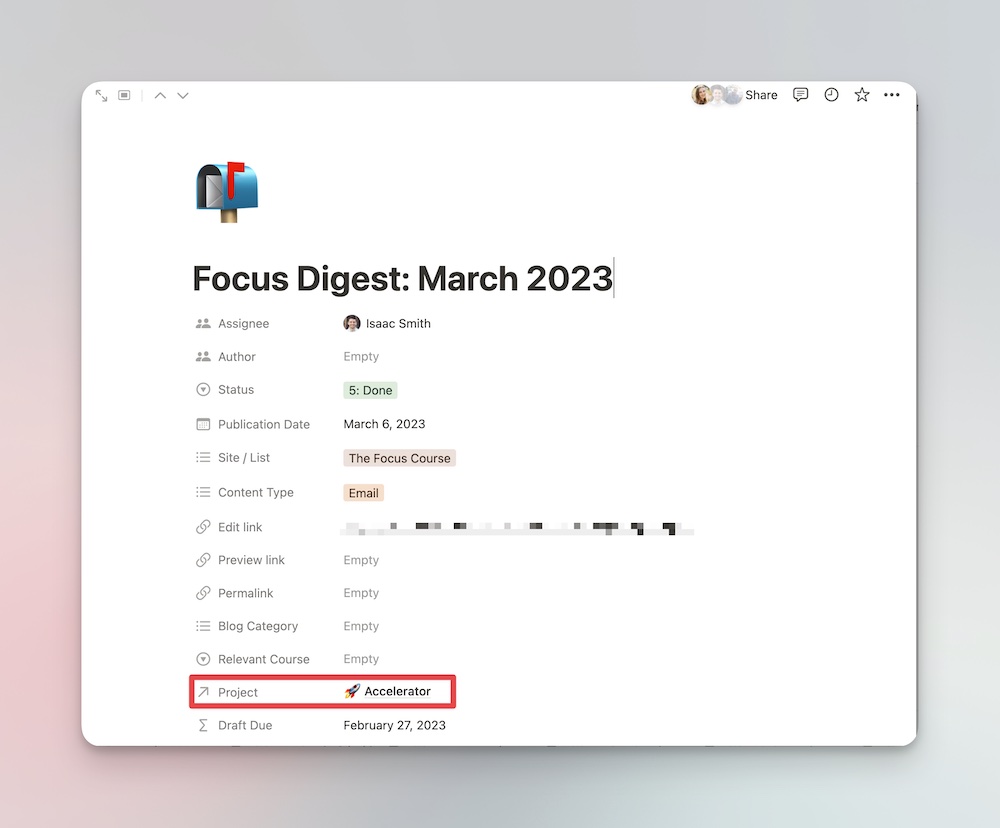
Chloe has her own private dashboard that shows her all the things (emails, articles, tasks etc.) that are assigned to her. Relation databases let her know the context.
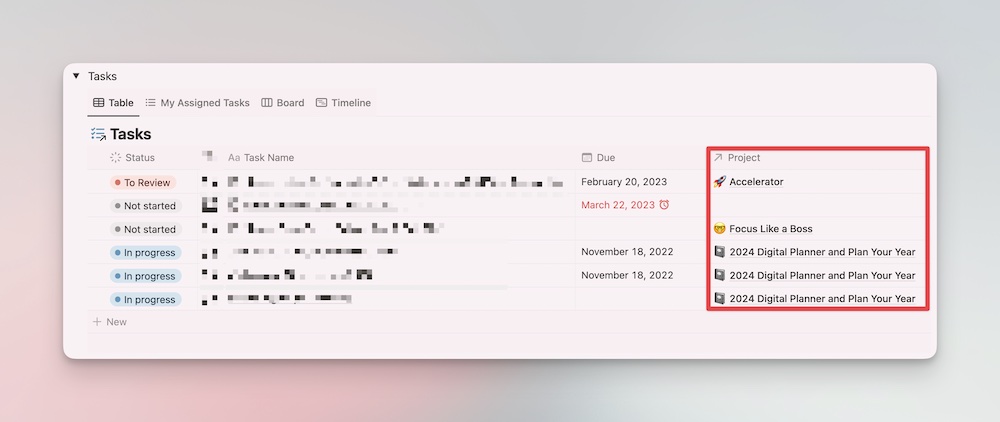
She can easily see the tasks that are assigned to her and the projects they are attached to. And yes, we are already working on the 2024 Digital Planner and Plan Your Year. ☺️
What if you have dozens or even hundreds of entries? There’s a handy search feature with relational databases. You can easily search for exactly the right entry you’re looking for.
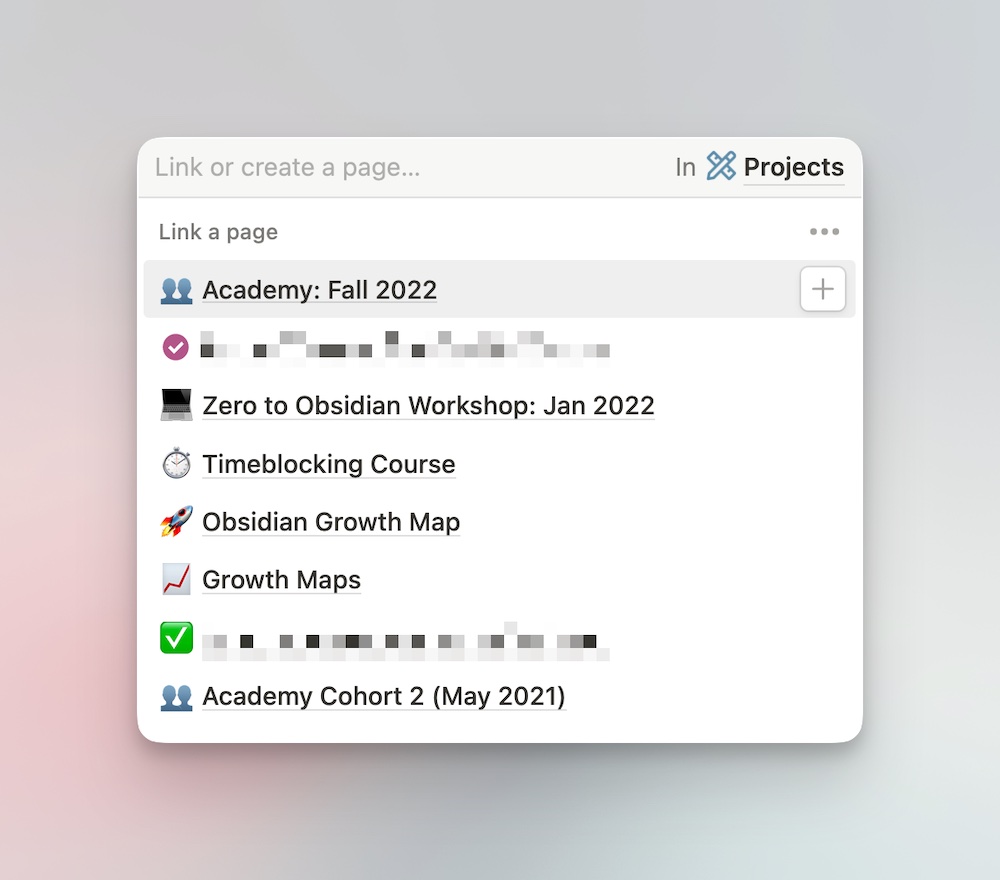
We apologize in advance for some of the Canadian tax lingo below. Here’s a quick breakdown of some of the terms:
This should cover the basics.
Here is the very simple structure our office utilizes inside Notion to manage our relationships with our clients:
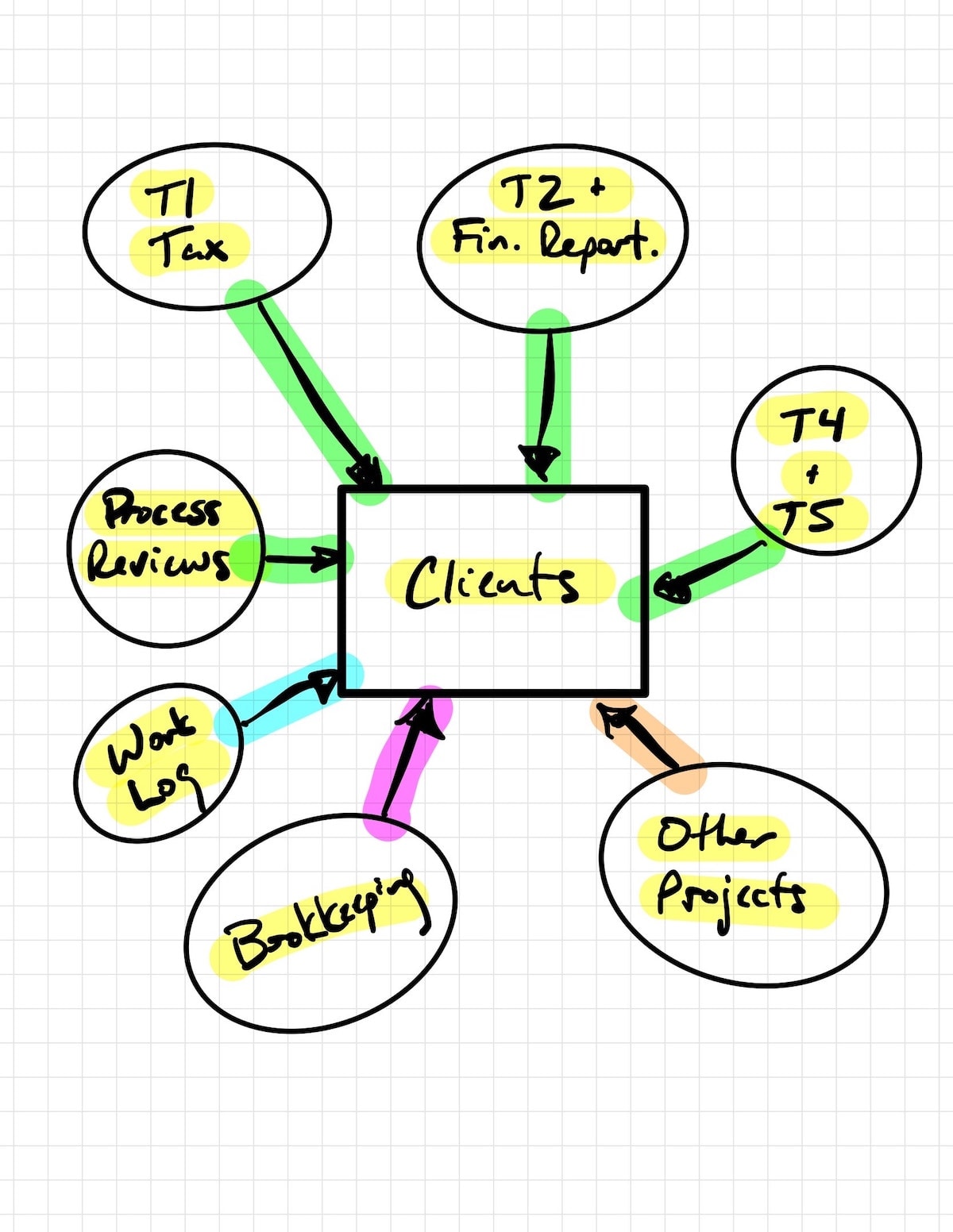
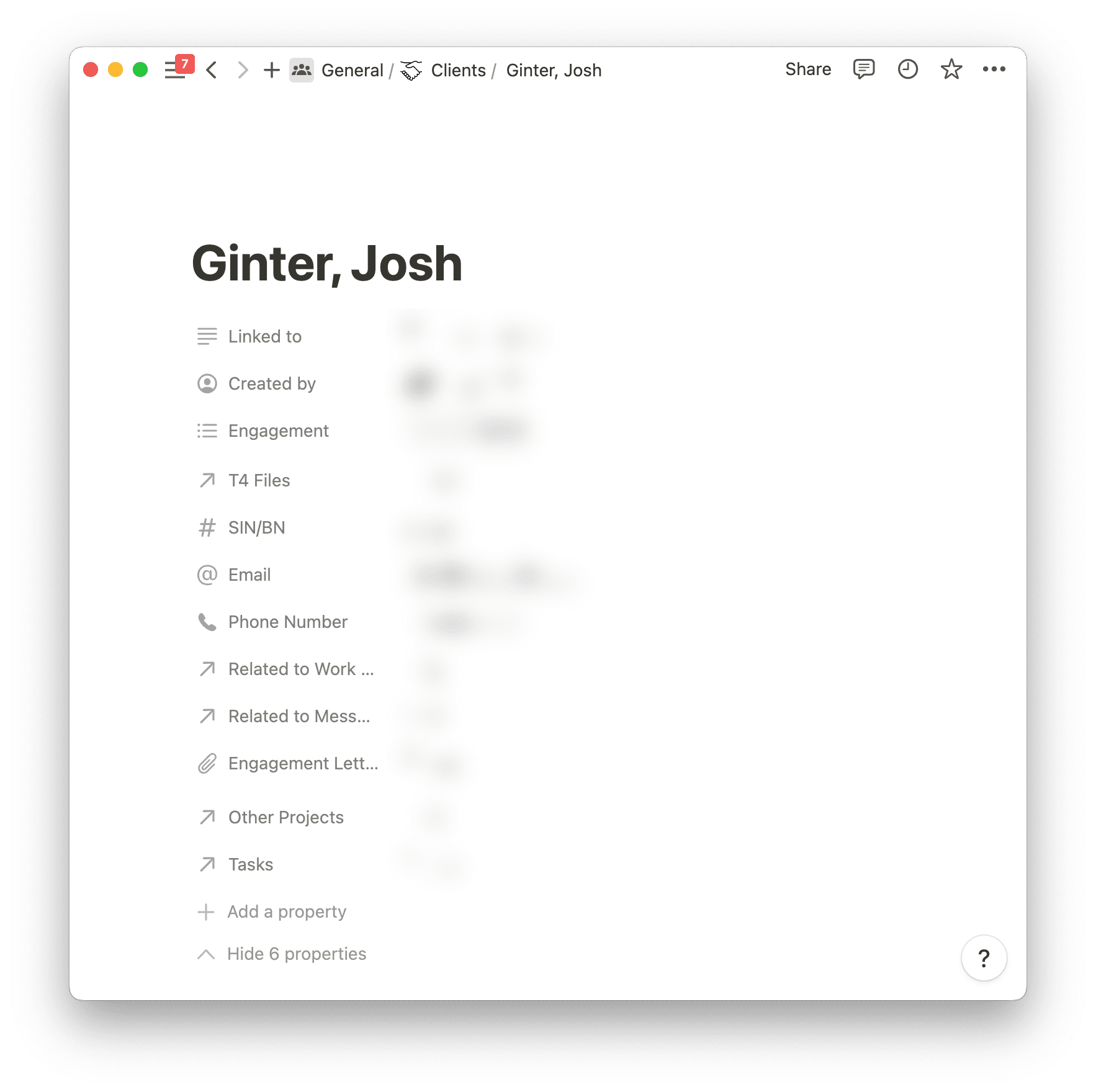
Each of these seven different databases houses various types of work we do for clients. Each database should have different items inside — a T2 and financial statement doesn’t have the same type of work as a T1 personal tax return, after all — but we could well do a T2, financial statement, set of T4s, and other work for a specific client. So we’ve built things out in such a way as to always have a property in every database item that relates back to an item in the “Clients” database to ensure better tracking and relationship management.
When searching for anything in Notion, it’s easy to jump into the Quick Search field in the top left corner. However, if this doesn’t immediately yield what we’re looking for, our relational database structure ensures we can start with “Clients” and then discover all connections to that client from across all 7 other databases. So long as we’ve properly filled in the relational database property in those other 7 databases, every client’s card in the “Clients” database should yield all the work we’ve ever done for that client.
In addition to all of the specific tax and financial reporting work we do for a client, we also have two separate miscellaneous-type databases to cover off miscellaneous-type work we might do for clients. If we mail out documents that need to be charged to a specific client, we can log the mail, log the type of document, log when it was sent, log the cost of postage, and relate it back to that specific client. If we ever need to do a quick check on mailing billings at a month-end or something, it’s as simple as applying a filter to all clients who have a populated “Mail Log” relation in their client card and get those onto an invoice.
Same goes for our “Work Log” database. This database houses any and all work we do for every client in the office. In many ways, it adds an extra layer of connection between our related databases. For instance, if we work on a specific client’s personal tax return for 3 hours on the morning of March 21st, we will create a work log entry stating we worked on that tax return for 3 hours. We can use linked database items to create a quick link to the item in the T1 – Personal Tax database, which itself is related back to the Clients database at the top. If we ever need to find how many hours it took to finish that tax return, we can begin by looking up the client in Clients, clicking on the related database property for the T1 – Personal Tax file, then clicking on the Work Log entry which shows as a back link in the T1 – Personal Tax card. In about 2 or 3 clicks, we have exactly how long it took to complete the work and have a better idea of what needs to be billed.
It’s these inter-database connections that ensure our office can better know what we’re doing for clients, how long it’s taking us to complete the work, and for whom we’re doing the work. Obviously this pays off when it comes time to bill, but it has an equally important impact on our relationship with each client — in only a few short clicks, I can refresh my memory on all the work we’ve done for someone and ensure our professional work is more informed and guided. This makes better use of our work time and provides better guidance for clients so we don’t retrace our steps on work we’ve already completed. So, sure, there’s a better bottom line for our office as a result, but we believe our relationship with each client has improved significantly due to our use of relational databases in Notion.
You might not have a robust editorial calendar or a tax company, but relational databases are still part of the magic of Notion. A couple of months ago we were doing a consulting job for a marketing and brand strategy company. Chloe spent some time creating a decked out Notion workspace for them.
They had a lot of moving parts. Dozens of clients, hundreds of past, current, and potential projects, tons of contractors they worked with on different projects… You get the picture. Lots of information.
Chloe was tasked with finding a way to get all of their information to talk to each other and show everything they needed to know quickly. It was fun.
She created a Master Client Database, Master Project Database, Master Contractor Database, Master Contractor Agreement Database (so they could easily find their contractor contracts for specific projects without digging), and a few others for meeting notes, etc.
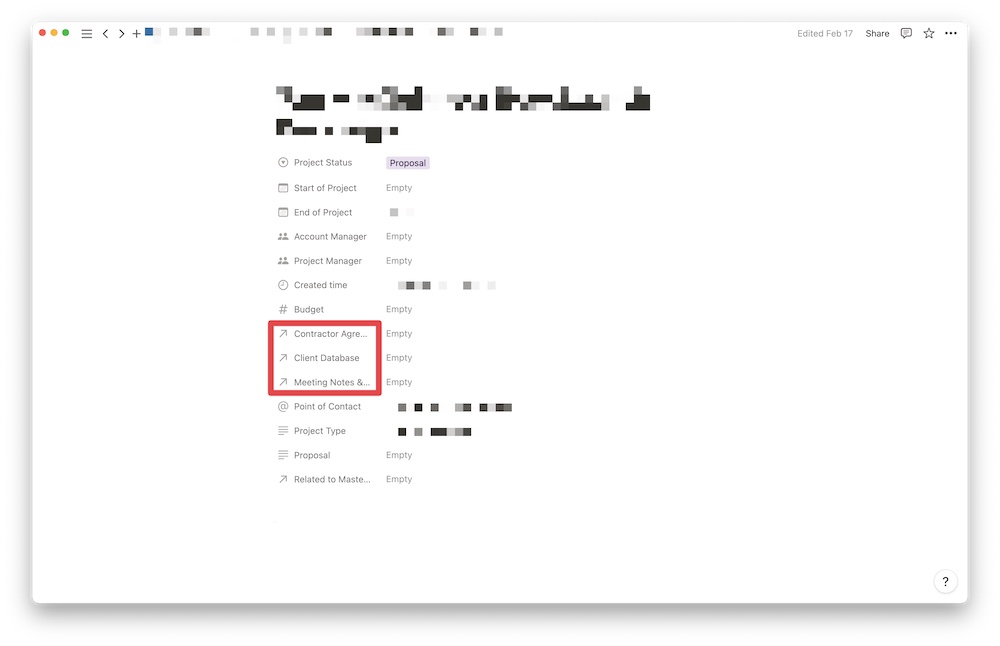
She made it so that they could easily jump into an existing project or create a new one and add the client it’s for, the contractors that are jumping onto the project, attach their agreements to the project, and any meeting notes that they take over the course of the project.
When you’re working on large projects for clients, the last thing you want to do is spend time tracking down information. It should all be in one place, easily accessible.
Relational databases create a one-stop shop for relevant information — no more digging through countless files folders or through your email looking for that one document. You can see it all in one place. Notion’s hallmark feature is a game changer.
You can take it to the next level and create an advanced tagging system similar to Obsidian using relational databases. I’ve created something like this, thanks to Marie Poulin’s Notion Mastery course, for my Notion Library.
Notion’s Rollup feature takes everything to the next level, allowing you to pull in even more information. But we can save that for another time.
Introducing the new Focus Boosters.
Inside our popular community membership, join us for a the Habit Building challenge (a.k.a. “Booster”). You’ll find out how to make simple changes that will make your daily life better, remove distractions, and create a new simple habit.
Membership Includes: Simple Habits Course, Habit Tracking Templates, Digital Planner, Private Community Slack, 2x Monthly Coaching Calls, and much, much more…
This week, we are kicking off our next Focus Booster inside the community. And it’s a Complete Guide to Margin.
There are only two ways you can restore margin to your life. And they’re actually quite simple…
As part of our upcoming Margin Reset — a done-with-you program — we will take you step-by-step through the mindsets you need, the obstacles to watch out for, and the steps you need to take in order to restore margin in every area of your life.
You will also discover the habits, systems, and routines you can build in order to KEEP margin for the long run. While anybody can quickly restore a little bit of breathing room using a few quick tips, it takes more than that in order to maintain margin in your life over time.
When your life has margin, you are able to focus your energy on doing your best work, showing up for those who need you, and living at a sustainable pace of life.
This community-led, mini-course is completely free for any and all members of the Focus Accelerator Membership.
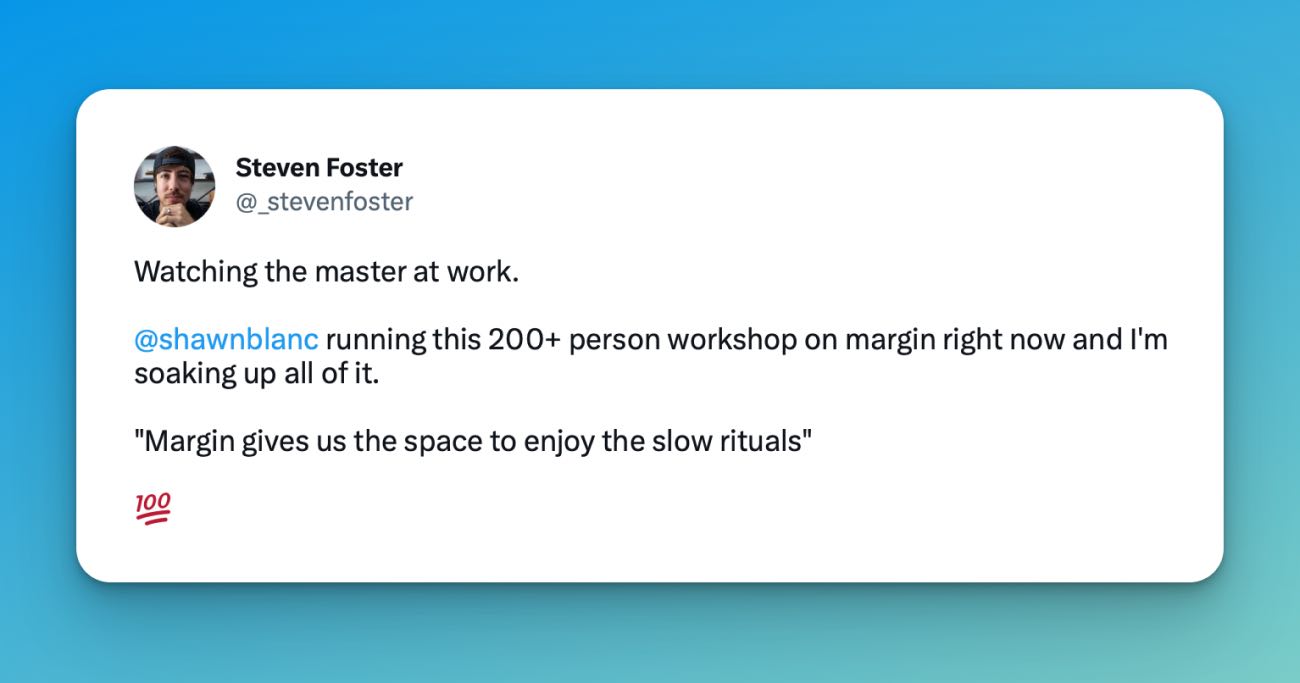
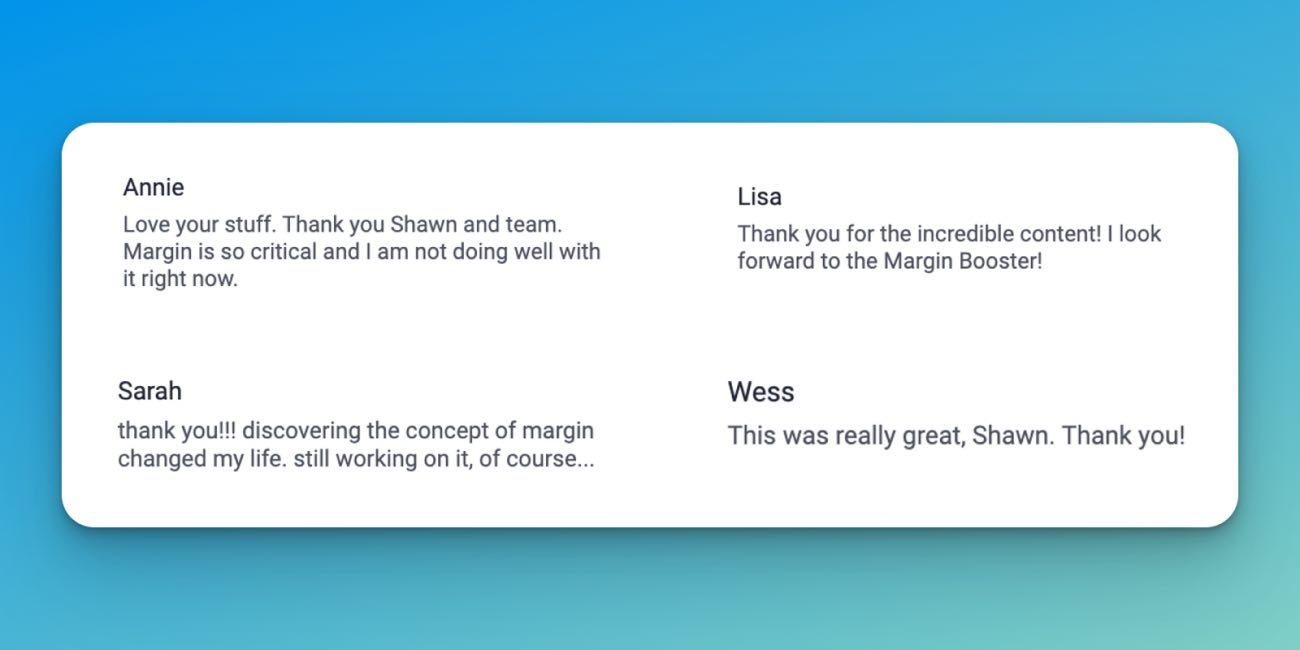
Inside our popular community membership, you’ll be able to join us for the Margin Reset that is starting later this week.
Stop wondering why it’s so difficult to keep breathing room in your life, and finally break free from the overwhelm…
Additionally, you’ll get instant access to the entire course library ($5,000 value), including our popular Focus Course, Margin masterclass, Time Management masterclass, productivity templates, and more…
All this, and more, inside the Focus Accelerator
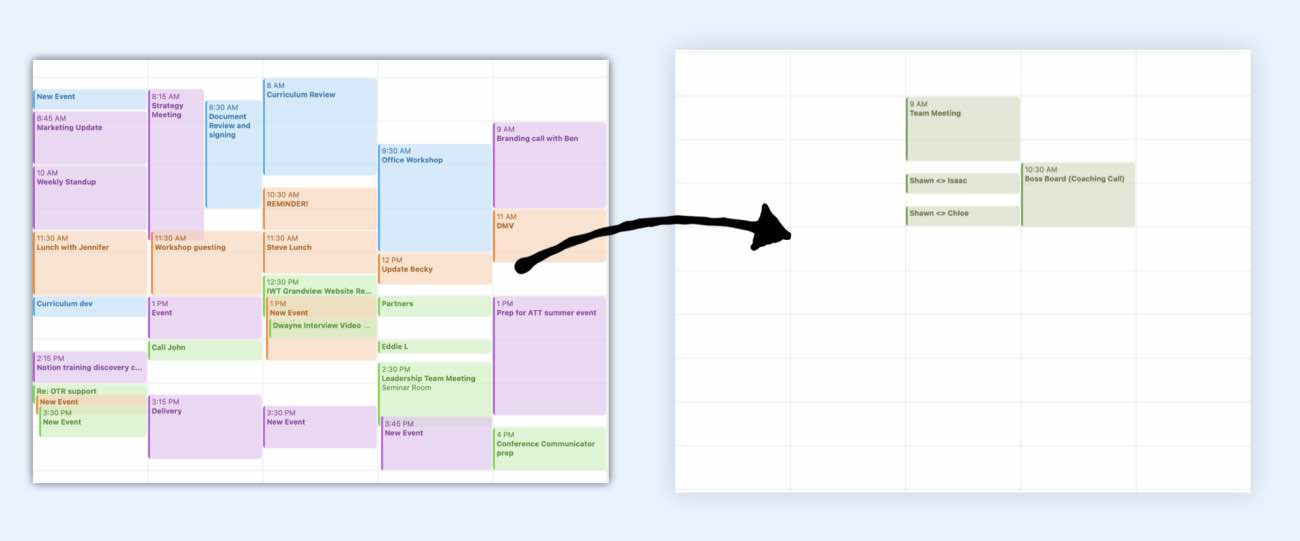
Join 300 focused members who have access to $5,000 worth of our best courses and mastercalasses, the Digital Planner, a Private Community Slack, 2x Monthly Coaching Calls, and much, much more…
As you may have heard, Focus Boosters are something new we are doing in 2023 for our Focus Accelerator members.
Each Booster is a community-led, themed challenge to help you up-level in a specific area of task, time, and idea management.
These are all the Focus Boosters happening in 2023:
The latest booster, Margin Reset, begins this week at our members-only coaching call (Tuesday the 14).
Get complete access to all the frameworks, training, coaching, and tools you need to restore breathing room in your day-to-day life.
Imagine, your life WITH margin. It means you’ll have:
A life with margin means is one with less stress and overwhelm in your work; more time on your calendar and more space for the things you love and want to do; more mental and emotional strength to show up for your relationships; and overall healthier work / life balance.
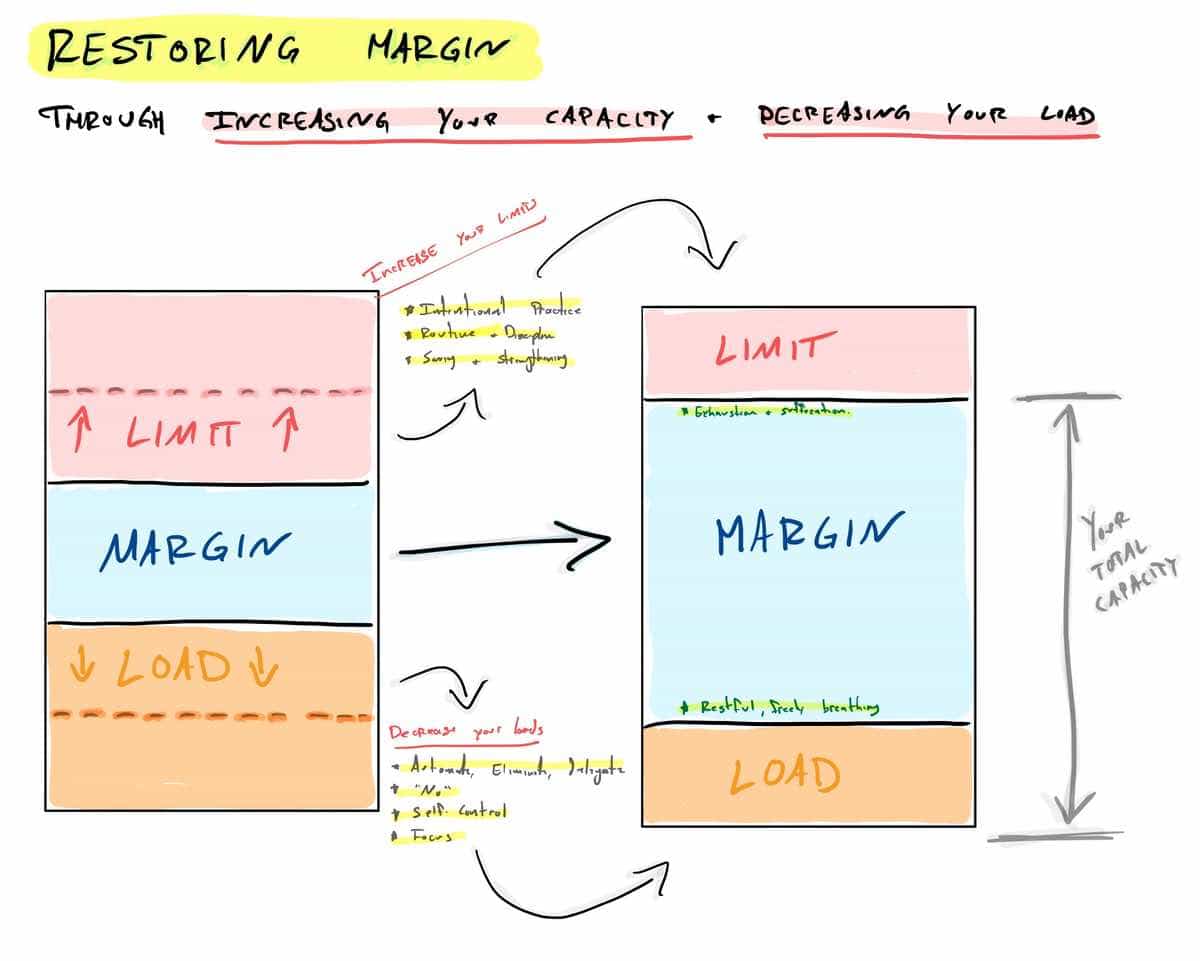
Here is the plan for the Margin Reset:
Step 1: Assess: Use our Margin Assessment to find out exactly where to focus first.
Step 2: Discover: The ideal next step you can take to restore margin in your life.
Step 3 Restore: Using our simple tools and frameworks, we’ll show you how to thrive with a life full of margin.
If you want to join us, sign up for the membership so we can help you get set up before things begin.
In addition to all the live Boosters, your membership also gives you instant access to everything in our entire library. Both here on The Sweet Setup as well as on our sister site, The Focus Course.
And when I say “everything in our library,” I mean you’ll have access to:
Your membership comes with both online and in-person coaching and community. You’ll also get:
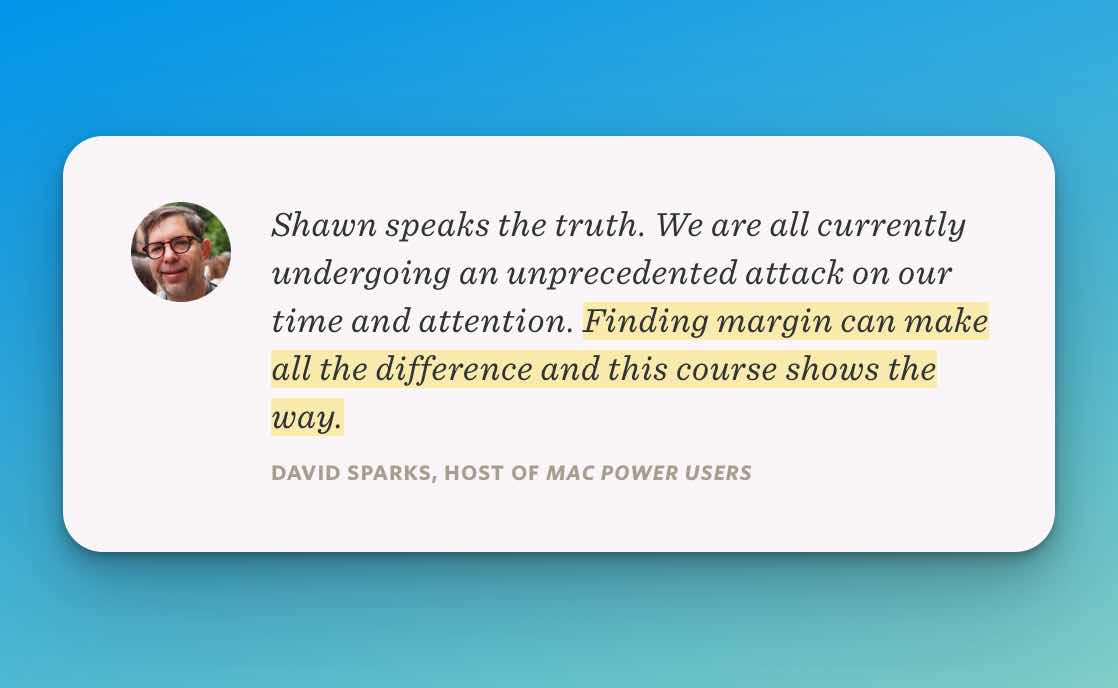

Quick wins are rarely the elements of a long-term strategy.
If you search for quick wins, you’ll find them. But they won’t add up to anything substantial over time.
Instead, focus on being consistent with smaller actions you can stick with over a long period of time. Here’s why…
There are two types of goals:
Attainment Goals are something we accomplish. Running our first marathon. Losing 10 pounds. Paying off student loans. Reaching 1,000 newsletter subscribers. There is a clear definition of done and you know when you have attained that goal.
Lifestyle Goals are something we “install” into our everyday life. Such as a daily reading routine, a workout routine, a writing habit, a financial budget. A Lifestyle Goal is a desired outcome we have for what we want our day-to-day life to be like.
On a practical note, these two types of goals go hand in hand.
For example, suppose you want to run a marathon. Naturally, you will need a daily routine of eating and exercise in order to have the strength and stamina for race day.
Moreover, while the marathon itself is a mountaintop type of experience — something exciting and memorable. The race day itself is not a life-changing event. Rather, you will be changed through the lifestyle goal that was required to get you there — the biggest impact on your life will not be the marathon itself, but rather the months of preparation leading up to the race.
The small actions of our Lifestyle Goals only add up if they are done consistently over time.
Any singular, small action that is done once will not produce any meaningful results in your life. This is true for good actions as well as bad actions. Such as:
Any of the above actions, if done once, will not add up to much in the long term. Smoking one cigarette will not be detrimental to your health. Skipping dessert will not impact your weight. Writing 500 words is not much toward a manuscript or a year’s worth of weekly newsletters.
However, if you were to take any of those actions and repeat them consistently for a year…. you would see substantial and noticeable results.
Writing 500 words per day adds up to more than 175,000 words — that’s a couple of books.
Walking 30 minutes per day adds up to about 700 miles in a year.
We do not decide our futures, we decide our habits. And our habits decide our futures. — F.M. Alexander
Whatever your goal is, pick a small daily action that you believe will move you toward that goal. And then, do that small action consistently in order to produce the results you are wanting.
This is a very simple strategy. And it works.
But, if you have ever tried to implement a new habit then you know that, while it may be simple it is not always easy.
And so, the question arises:
How do you maintain consistency and motivation to show up every day for those small actions that compound over time?
Introducing the new Focus Boosters.
Inside our popular community membership, join us for a the Habit Building challenge (a.k.a. “Booster”). You’ll find out how to make simple changes that will make your daily life better, remove distractions, and create a new simple habit.
Membership Includes: Simple Habits Course, Habit Tracking Templates, Digital Planner, Private Community Slack, 2x Monthly Coaching Calls, and much, much more…
One of my personal favorite methods for getting new habits to stick and old habits to keep going is through the use of a habit tracker.
There are all sorts of habit trackers available — from apps to notebooks to wall calendars. I’ll list a few of my favorite habit trackers at the end. But first, let’s briefly look at the 3 main benefits of using a habit tracker.
As is often the case, once you begin focusing on a new habit, or doubling-down on an old one, you will have many new ideas for something different you could be doing instead.
Your habit tracker will help remind you of the critical actions you are committed to doing each day. This will help you to stay consistent on the winning strategy instead of getting distracted by new ideas, quick wins, or other distractions.
In order to get the results from your small, daily actions you need to actually do them. It’s not enough to want to write 500 words per day, you actually need to do it.
Like I shared earlier, a small action done once doesn’t add up to much. You have to keep showing up every day. By using a habit tracker you are able to stay focused on the one or two daily habits you are building so you can continue to show up and repeat them consistently.
The very nature of doing small things exactly that: they are small. And, as such, it can be easy to lose sight of the bigger picture and to stay motivated.
This is why it’s important to recognize and celebrate the small, daily wins of our life.
Research shows that our motivation increases when we see that we are making progress on meaningful work. This recognition of progress boosts our overall mood and thus leads to an increase in productivity and creativity.
Even a simple habit tracker can help you to catalog and celebrat your small wins each day so that you can be reminded you are making meaningful progress.
We have tried, tested, and used many habit trackers over the years. We even designed our own and put it inside our Focused Life Digital Planner. Here are a few of our favorites.
Habit Tracking Apps
The best habit tracking app for your iPhone is Streaks. It offers everything you need to create good habits or break bad ones, features a great design that is very customizable, has some useful widgets, integrates directly with the Apple Health app for automatic tracking, and offers great support for Shortcuts.
Focus Course Digital Planner
Our popular digital planner has 12 monthly spreads for you to celebrate your daily progress and track your daily habits.
![]()
Day One
If you want to build a journaling habit, I’m a huge fan of Day One (and have been using it for nearly a decade). While Day One isn’t a traditional habit tracker, you can use it track your habits by either using a journal template and/or by simply writing down what you did each day.
If you already use Day One, then this could be great for you if you also want to keep things all in one spot. Or, if you’re specifically looking to build a journaling habit this year then Day One is an ideal spot to start.
Notion
There are hundreds of habit tracking templates out there for Notion.
We just designed and developed our own Notion Habit Tracker (based on the best of the best) and we’ll be publishing it for free to everyone inside the Accelerator Membership.
Notebooks
For me personally, I track my daily habits inside of a standard-issue Baron Fig notebook. I map out my own “one line per day” method with a daily highlight and a few check boxes for the habits I am currently tracking.
If you’re looking for even more suggestions on ways to track your habits and routines, here’s another roundup.
Introducing the new Focus Boosters.
Inside our popular community membership, join us for a the Habit Building challenge (a.k.a. “Booster”). You’ll find out how to make simple changes that will make your daily life better, remove distractions, and create a new simple habit.
Membership Includes: Simple Habits Course, Habit Tracking Templates, Digital Planner, Private Community Slack, 2x Monthly Coaching Calls, and much, much more…